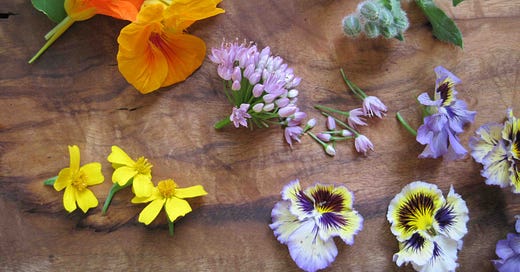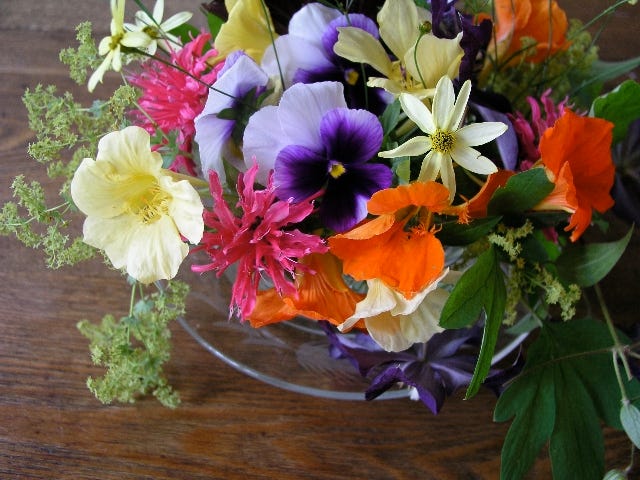“Then the flowers became very wild because it was early September, and they had nothing to lose.” - Grace Paley.
Hello Everyone.
The inspiration to be a gardener is often triggered by a beautiful garden or growing up in a family of gardeners. It happened to me while shopping for dinner, feeling aimless in the vegetable aisle. I spun the seed packet rack to see what was available when a stunning star-shaped iridescent blue flower called Borage caught my eye. Next to it was a salmon-colored nasturtium, and nearby was a canary yellow calendula—instant seduction. I bought a packet of each and plotted out my first garden on graph paper while making dinner that night.
My design was stunning, yet I had no clue how to start a garden and all the planning involved before pushing the seeds into the soil. This happened years ago when I had a good idea of how it all worked, but no one had shown me how to take a shovel and sculpt the design—or even how to design a garden—yet I was eager to give it a try.
Looking for love in the supermarket proved easy, yet my husband was not pleased. He prided himself on being the vegetable gardener, which was all about producing food, and there was no room for flowers. Ornamental anything did not belong in a productive, functional garden, even if these were all edible flowers. He pointed to a tiny plot beyond our proper garden, far away from the house, and let me borrow his shovel.
I removed a thick layer of rugged turf, dug the stony soil, and shoveled on some compost, stealing it from his pile, hoping he wouldn’t notice. The garden measured 6’ X 6’ feet, not very big, but big enough for three packets of flower seeds. I stretched out twine to create an artful spiraling shape, my alternative to the more straightforward, long, straight rows, pushed the seeds into the ground, and walked away.
To my surprise, the seeds sprouted almost overnight, then the plants snowballed and spread to fill the entire garden. I would be stretching the truth if I said the garden thrived. There was a constant battle with the weeds, and the garden hose never quite reached. Yet I felt an enormous sense of pride with my first garden, even though a more seasoned gardener would consider it a total mess.
Most edible flower stems are not made to go into a vase. They are too short or tall; stems are too thin or wavy to make it into a vase. It’s just not that type of flower. But what edible flowers lack in practical beauty, they make up for in flavor and productivity. The more you cut, the more they grow, and best of all, many are quickly grown from seed sown directly in the garden. There is no need to depend on buying starter plants from a nursery or use plastic pots to get them started.
As a new gardener, this made me feel instantly successful and lucky. And even though my first attempt at a garden was not ideal, I’ve played the field enough now, decades later, when it comes to growing edible flowers. I remain loyal to Borage, Nasturtiums, and Calendula. They self-sow easily, so I no longer even need to buy seeds. They spread themselves around freely.
The sole purpose of an annual flower is to make a flower that turns into a seed pod. If the flower is not picked, the seeds will spread everywhere. It's nature’s way of creating a natural habitat for birds, bees, and other creatures. And while it can be somewhat invasive if left to go too wild, there is something quite appealing about an untamed landscape, with beds of edible flowers overflowing everywhere.
Borage: Folklore attributes borage with courage and comfort to mend a broken heart, made into a tisane to sip hot or cold. In contrast, syrups made with borage flowers are thought to heal various autoimmune disorders such as arthritis, eczema, and menstrual cramps.
A single plant will boost the native bee population, especially popular with small native bumbles, and is a host to lacewings, an aphid-eating insect. The smell of the borage plant is thought to repel tomato hornworms, a valuable companion plant in the kitchen garden.
Nasturtiums: Bright salmon pink, yellow, tangerine orange and mahogany red nasturtiums come in at least two dozen color combinations. They deliver everything a garden could ask for, with a perky, peppery flavor in the blossoms and leaves. Sprinkled with lettuce in a salad or dot a plate of deviled eggs, nasturtiums multiply from seed and spread through a garden like wildfire.
Monet planted them in the border at Giverny, training them to ramble over a gateway trellis. At the Isabella Stewart Gardner Museum, they hang down in the courtyard, giving the impression of Rapunzel’s golden braid practically touching the ground. Seeds are in every grocery store or seed catalog, and it is advised to grow them often and everywhere. No holding back.
Calendula: While there is no substantial evidence to support the use of calendula for any purpose beyond the delicate edible petals, it has been traditionally used in the Ayurvedic system of medicine to heal wounds, rashes, and skin infections.
Calendula is a natural dye that produces honey, gold, orange, and vibrant yellow tones. It can also be made into a cream to soothe dry skin and as an edible petal sprinkled into a salad with a mild sweet taste that is slightly bitter. The flowers turn quickly from petals to seed heads, then shatter easily, bursting into a hundred tiny parts that will continue to reproduce throughout the garden.
If you are dressed up and ready to find love in the garden or a supermarket, consider settling for a few packets of edible flowers. It is best to grow as many as possible, squeeze them into the beds, and sow them all summer for a continuous harvest. There will be no regrets.
From my garden to yours,
Ellen O
Ellen Ecker Ogden is a kitchen garden designer, author, and lecturer. Follow on Instagram @ogdenellen.
Welcome to the Art of Growing Food newsletter. You will find artful tips on growing and cooking for cooks who love to garden. You are receiving this newsletter because you are a free or paid subscriber. Thank you! - Ellen Ecker Ogden











Love this today . . . "What edible flowers lack in practical beauty. . ." Stepping outside to admire mine now. Thank you!
This is beautifully written, and very informative in a romantic and whimsical way. In my mind there is always room for more flowers in the vegetable garden :)